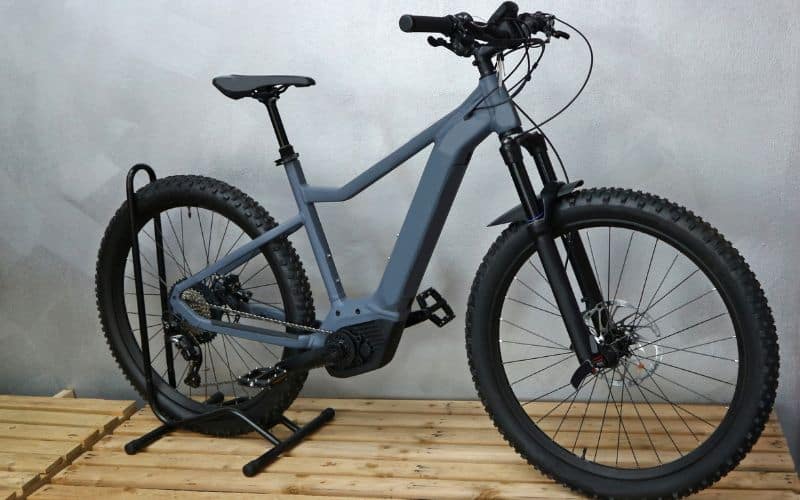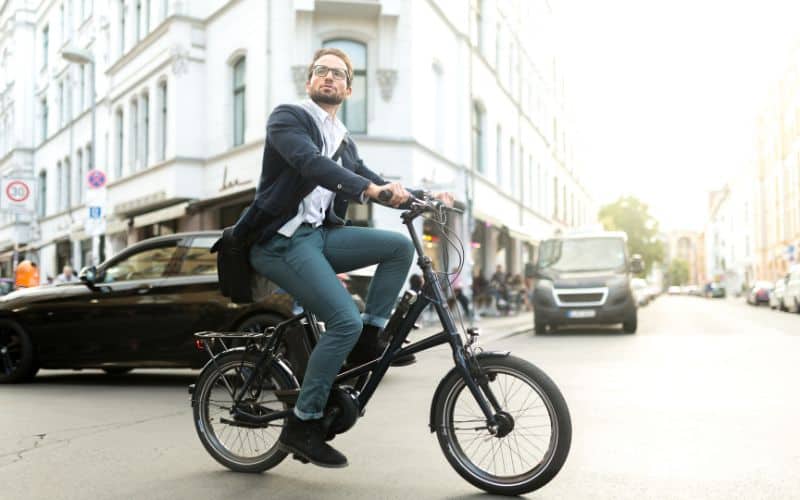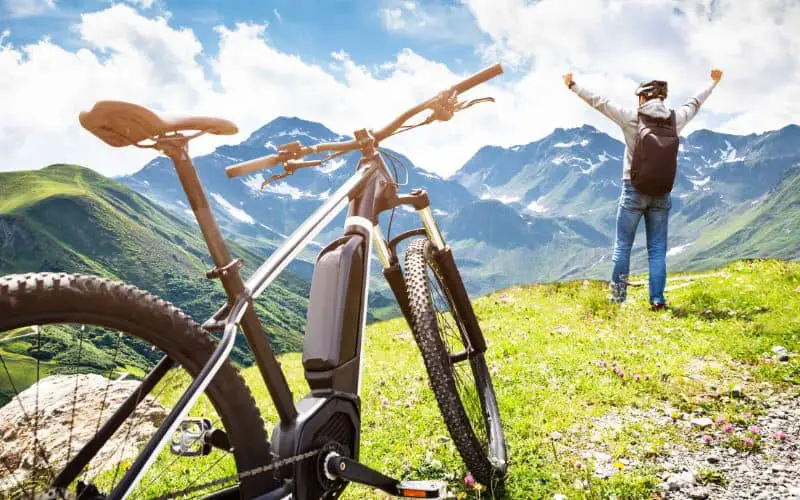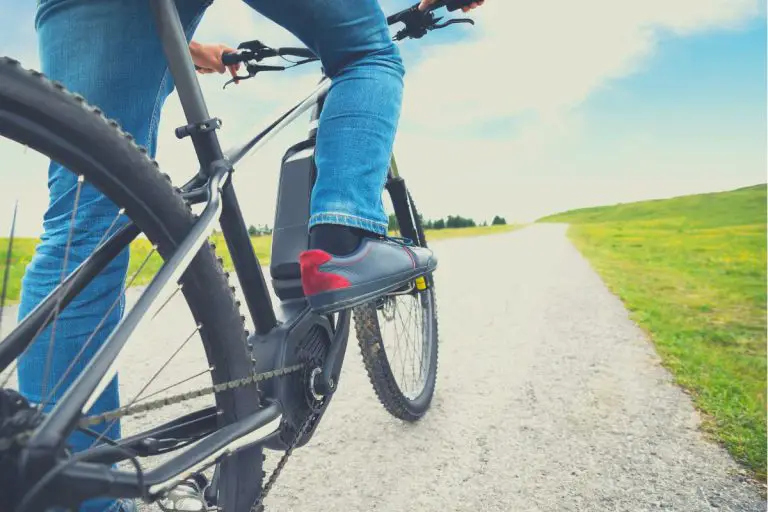Whether you have a long hilly commute or want to enjoy a more comfortable ride on a mountainous trail, you’ve probably considered buying an electric bike.
E-bikes, also known as electric bikes, are powered by a motor, putting less strain on the rider over long rides. Steep upclimbs are the bane of all riders because it takes a lot of energy to get up them, so it makes sense why you’d be interested in purchasing an e-bike.
So, can e-bikes actually go up steep hills? Continue reading to find out.
Do E-Bikes Go Up Steep Hills?
Unsurprisingly, E-bikes can go up steep hills like standard bikes. With both e-bikes and regular bikes, to go up steep hills, you do a process called “downshifting,” which means you change from the upper gear to the lower gear.
If you didn’t already know, riding on the lower gear has the least resistance, and the upper gear has the most resistance (so use that going downhill).

Quick Guide On E-Bike Gears
Most e-bikes have derailleur gears, but some also have hub gears.
If you are looking at an e-bike, there is a front and rear derailleur. Both derailleur gears are connected by a chain, which is spun around a cassette, and lead through a chain wheel or sprocket. Shifting between gears, a.k.a. changing the tension, is done through the handlebars on your bike.
The front and rear gears have different amounts of teeth, usually indicated in the name of the bike model. If your bike has fewer teeth in the front or more in the rear, it will become easier to pedal.
When you change gears to go uphill, you want to pick up steady speed, keep up a rhythm, and switch to the lower gear earlier than later. It is essential to gain momentum, derailleur gears are often the best option for uphill rides. People who go offroading or bike around mountains prefer having fewer teeth in the front and more in the rear.
Alternatively, hub gears are another option. Hub gears are sealed in a hub and use an entirely different gear system than derailleur gears. Hub gears are comprised of multiple gears, typically three, four, five, seven, eight, or eleven. These are alternated from using a level or twist-handle. You can shift from any gear while moving or in a stationary position.
Hub gears last longer and are safer than derailleurs but are mainly only used by people in urban areas. Hub gears are also heavier and more expensive than derailleurs, making uphill climbs a bit more challenging.

What Is A Steep Hill?
How long is a piece of string? 🤪
Seriously, when talking about cycling, “gradient” refers to the steepness of a hill. Roads can have a positive or negative gradient. If a road has a positive gradient, it goes uphill, and a negative gradient means it goes downhill.
Gradients are measured by the vertical distance of a climb divided by the horizontal distance. Gradients always come out as a percent. Signs along roads, paths, and trails often indicate the percent incline along with a triangle symbol.
Can An Electric Bike Go Up Steep Hills?
If you are reading this article, you probably already have experience biking up steep hills. Keep in mind that it is easier to ride uphill with a motor rather than without one.
For those attempting to ride uphill without a motor, look at this guide. It will explain how easy hill gradients should be to ride up, giving you a better understanding of how powerful an engine you need.
Hill Gradient Guide:
- 0%: A flat road.
- 1-3%: A mild uphill ride.
- 4-6%: A slight gradient that can be challenging for beginner riders or over long sections.
- 7-9%: More than a challenge for beginner riders and irritating even for experts.
- 10-15%: Impossible for beginner riders and something even the most seasoned riders try to avoid, unless for short bursts.
- 16% and Higher: Extremely challenging, bordering on impossible.
What Type Of E-Bike Is Best For Hilly Rides?
Like regular bikes, e-bikes can be categorized into urban and mountain bikes. There are a few other less important categorizations. Both urban and mountain e-bikes can go up steep hills, but each has unique perks and design features.
Regarding power, you get what you pay for with e-bikes. Regardless of the model. Motor power is directly reflected in the amount you pay, and the more powerful the motor, the easier it is to ride up hills!
On average, base-level mountain e-bikes have a higher wattage capacity, but if you are concerned about steep hills and want an e-bike, you won’t buy a base-level model. Try to shoot for at least 500w for a comfortable ride if you don’t want to pedal too much.
Mountain e-bikes have lighter and more durable frames, better traction, and better grip. Urban bikes are heavier and safer to ride, and most models don’t require pedaling.
If you are looking for an e-bike for a hilly commute, consider how far your commute is and how much power the battery can hold. Other essential factors include portability, frame design, breaking technology, and price.
Related article – Can You Carry An Extra Battery For An Electric Bike?

Why Are Mid-Drive Motors Better Than Hub Motors For Steep Hills?
Asides from gears and bike design, choosing the right type of motor is vital for relaxing uphill e-bike rides.
The two most common motor options for e-bikes are mid-drive and HUB motors.
- Mid-drive motors are directly connected to the gears during assembly and apply torque to the wheels using a chain ring.
- HUB motors are connected to either the front or rear wheels and apply torque directly to the wheels, working independently of the gears.
E-bikes with mid-drive motors are more expensive than HUB motors. However, mid-drive motors use less energy and feel more cohesive with the bike when riding. E-bikes with mid-drive motors conserve more energy riding uphill rather than those with HUB motors, which means you can ride for longer on a single charge.
Mid-drive motors are heavier than HUB motors.
E-bikes with HUB motors are easier to store, and there are even foldable models. However, not many would recommend an e-bike with a HUB motor to someone who goes uphill frequently.
Interesting read – When You Pedal An Electric Bike Does It Charge The Battery?
The Three Class Of E-Bikes
E-bikes can be broken up into three classes, depending on the power of their motor. There are different regulations regarding these three classes, and some perform better in certain environments.
- Class 1 – these are low-speed pedal-assisted electric bikes. It must have a motor that only operates when a rider is pedaling. The motor turns off when the rider goes above 20 mph.
- Class 2 – these are low-speed throttle-assisted electric bikes. A Class 2 bike’s motor also cuts off when a rider goes above 20 mph. The main difference is that you don’t have to be pedaling for the engine to operate.
- Class 3 – these are speed pedal-assisted electric bikes. The bike motor will only keep running when the rider pedals like Class 1 bikes. However, the engine turns off when the rider reaches 28 mph. All Class 3 bikes are equipped with a speedometer.
Class 1 and Class 3 e-bikes have a pedal-assist feature, which means you must pedal for the motor to run. Class 2 e-bikes are throttle-assisted, so you hold down a throttle to power them, just as you would a motorcycle.
You may also be interested in:

